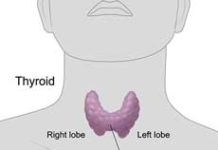To check if an area of your body has cancer, your doctor may recommend a fine needle aspiration biopsy. The information in this article can help you understand the procedure and get ready for your appointment.
What is a fine needle aspiration biopsy?
A biopsy collects tissue from a possible tumor or area of concern so it can be examined under a microscope. Other tests may be performed on a biopsy sample, too, that do not necessarily involve a microscope. Biopsy is the main way doctors diagnose most types of cancer. There are many types of biopsies, including a fine needle aspiration biopsy.
To perform a fine needle aspiration biopsy, the doctor inserts a very thin, hollow needle through the skin and into the suspicious area. The syringe attached to the needle suctions out a small sample of cells and sometimes fluid. This procedure may also be called a fine needle biopsy or FNA. It is the least invasive, called minimally invasive, of the different biopsy methods.
A fine needle aspiration biopsy may also be performed during an endoscopy or bronchoscopy. An endoscopy is a procedure that allows the doctor to view the inside of a person’s body, and a bronchoscopy is a procedure that allows the doctor to view the inside of a person’s lungs. Learn more about the types of endoscopy and how to prepare for one.
Why might I need a fine needle aspiration biopsy?
Most cancers can only be definitively diagnosed with a biopsy. Your doctor may recommend a fine needle aspiration biopsy if they feel a mass through your skin. They may also recommend this biopsy if they see something suspicious during other tests and procedures. If the mass is deeper in your body, imaging tests, such as an ultrasound, a computed tomography (CT) scan, or magnetic resonance imaging (MRI), can help guide the biopsy needle to the right spot. This is called an image-guided biopsy.
The biopsy may be performed by your doctor, a pathologist, or a radiologist. A pathologist is a doctor who specializes in interpreting laboratory tests and evaluating cells, tissues, and organs to diagnose disease. A radiologist is a doctor who specializes in diagnosing disease using imaging tests.
Common areas of the body where a fine needle aspiration biopsy is used to check for cancer include the thyroid gland, lymph nodes, breast, liver, lungs, and skin. However, the procedure can be used in most areas of the body.
The tissue collected during the biopsy is then sent to a laboratory so a pathologist can analyze it. Your biopsy results will show whether the tissue removed was from a tumor. If there is a tumor, the biopsy will help reveal if it is cancerous or benign. A cancerous tumor is malignant, meaning it can grow and possibly spread to other parts of the body. A benign tumor means the tumor can grow but will not spread. This information is very important in helping your doctor determine if further diagnostic testing is needed. If further testing is not needed, it can help them recommend the best treatment plan for you.
In people who have already been diagnosed with cancer, a fine needle aspiration biopsy may also be used to evaluate whether an area of concern is related to the cancer spreading elsewhere in the body, called metastasis. Or, it might be used to determine whether a new and different type of cancer, called a second cancer, has formed.
 “Fine needle aspiration biopsy is a widely employed, minimally invasive, and generally very low-risk approach used to help diagnosis new or recurrent cancer.” – Jeffrey E. Gershenwald, MD, FACS, professor in the Department of Surgical Oncology in the Division of Surgery at The University of Texas MD Anderson Cancer Center in Houston, Texas, and Cancer.Net Editorial Board member.
“Fine needle aspiration biopsy is a widely employed, minimally invasive, and generally very low-risk approach used to help diagnosis new or recurrent cancer.” – Jeffrey E. Gershenwald, MD, FACS, professor in the Department of Surgical Oncology in the Division of Surgery at The University of Texas MD Anderson Cancer Center in Houston, Texas, and Cancer.Net Editorial Board member.
What can I expect during a fine needle aspiration biopsy?
A fine needle aspiration biopsy may be done in your doctor’s office or at an outpatient clinic. If the biopsy needs to be image-guided, a radiologist may do it at an imaging facility, hospital, or other medical center. Depending on what area of your body is biopsied, you may need to remove your clothes and wear a hospital gown. The area will also determine if you need to sit up or lie down on your back, side, or stomach. It is important to hold still during the procedure.
Your doctor may initially numb the biopsy site with a topical medication that is spread on the skin. Sometimes, they will inject a medication into the biopsy site to prevent pain in tissues beneath the skin. Then, they will insert the biopsy needle. The doctor may repeat the biopsy more than once during your procedure to collect tissue from different parts of the suspicious area. The entire procedure can take between 15 minutes and 1 hour, depending on the body part involved and whether imaging is used.
What should I do before my fine needle aspiration biopsy?
You do not need to do much to prepare for a fine needle aspiration biopsy. Your doctor may ask you to temporarily stop taking certain medications a few days before the test, including blood thinners such as aspirin, clopidogrel (Plavix), and warfarin (Coumadin). It is also a good idea to ask your doctor if you should stop or avoid any medications prior to your planned procedure.
When you arrive for your appointment, your doctor or another member of the health care team will make sure you understand the benefits and risks of the biopsy procedure and ask you to review and sign a consent form. You should always talk with your doctor about any concerns you may have before the procedure. Also, ask your doctor how you will get the biopsy results and who will explain them to you. The results often come back within 2 to 3 days from the laboratory, but results can sometimes take longer.
What will recovery be like after a fine needle aspiration biopsy?
There is usually no recovery time needed after most fine needle aspiration biopsy procedures. The doctor may place a small bandage over the biopsy area. You should receive any special care instructions after the procedure. After most fine needle aspiration biopsy procedures, you can drive yourself home and go back to your normal activities right away.
Sometimes, the biopsy site may feel sore. In rare cases, infection or bleeding can occur. Call your doctor right away if you develop a fever or have continued bleeding, swelling, or pain at the biopsy site that does not stop.
What happens when my biopsy results come back?
Just because you have a fine needle aspiration biopsy does not mean you have cancer. The suspicious area may be noncancerous. Or, you may have abnormal cells that can be removed or destroyed before they become cancerous. If the pathologist needs more tissues to make a diagnosis, you may need to repeat the biopsy or undergo a different procedure.
If the biopsy does diagnose a new cancer, information in the pathology report, such as the type of cancer and its stage, helps your doctor refer you to an oncologist for treatment. An oncologist is a cancer specialist. The report may also include information about specific genes, proteins, and other factors unique to your tumor that can help guide your treatment options.
Ask your doctor to explain the different parts of the pathology report to you so you clearly understand your diagnosis. You may need to have further tests done after your fine needle aspiration biopsy to determine your diagnosis before cancer treatment begins.







